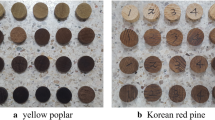Summary
Longitudinal air permeability measurements were made on specimens of British Columbia Interior and Coastal types of Douglas-fir (Pseudotsuga menziesii [Mirb.] Franco) sapwood and heartwood, kiln dried and solvent dried, which were successively reduced in length from 3.5 to 0.5 cm. Most sapwood, which was quite permeable, was found to obey Darcy's law with respect to length. Heartwood and kiln-dried Interior sapwood specimens were less permeable, and were found to deviate from Darcy's law. A physical model was proposed in which, due to random blockage of tracheids by aspirated pits, the number of conducting tracheids was reduced exponentially with depth of penetration. This was expressed as a linear relationship between the logarithm of permeability and specimen length at lengths exceeding one tracheid. This model conformed with the experimental data. A new mathematical equation was proposed:
which differs from the Darcy equation only by the insertion of e-bt, where e = base of natural logarithms andb is a positive constant determined by experiment. Whereb=0, e-bl=1, and the equation reduces to the Darcy equation.
Similar content being viewed by others
References
Adzumi, H. 1937a. Studies on the flow of gaseous mixtures through capillaries. III. The flow of gaseous mixtures at medium pressures. Bull. Chem. Soc. Japan12 (6): 292–303.
—, 1937b. On the flow of gases through a porous wall. Bull. Chem. Soc. Japan12 (6): 304–312.
Amemiya, S. 1962. Research on wood preserving treatment. III. Measuring the penetration factor of a few softwoods in the fiber direction. J. Japan Wood Res. Soc.8 (2): 81–86.
Anderson, B. E., Gortner, R. A., Schmitz, H. 1941. Factors affecting the decreasing rate of flow of liquids through wood. Tech. Bull. Minn. Agr. Exp. Sta., No. 145.
Bailey, P. J. 1965. Some studies on the permeability of wood in relation to timber preservation. Rec. a. Conv. Br. Wood Preserv. Ass. 31–50.
Bramhall, G.,McLauchlan, T. A. 1970. The preparation of microsections by sawing. Wood and Fiber2 (1): 67–69.
—,Wilson, J. W. 1971. Axial gas permeability of Douglas-fir microsections dried by various techniques. Wood Sci.3 (4): 223–230.
Buckman, S. J.,Schmitz, H.,Gortner, R. A. 1935. A study of certain factors influencing the movement of liquids in wood. J. Phys. Chem.39 (1): 103–120.
Buro, A.,Buro, E. A. 1959. Untersuchungen über die Durchlässigkeit von Kiefernholz. Holz Roh- Werkstoff17 (12): 461–474. (U.S. Dep. Agr., Forest Serv. Transl. No. 623).
Erickson, H. D. 1960. The effects of storage conditions and time upon permeability of green sapwood. Amer. Wood Preserv. Ass. Proc.56: 156–165.
—,Crawford, R. J. 1959. The effect of several seasoning methods on the permeability of wood to liquids. Amer. Wood Preserv. Ass. Proc.55: 210–219.
—,Estep, E. M. 1962. Permeability of Douglas-fir heartwood from Western Washington. For. Prod. J.12 (7): 313–324.
Erickson, H. D., Schmitz, H., Gortner, R. A. 1937. The permeability of wood to liquids and factors affecting the rate of flow. Tech. Bull. Minn. Agr. Exp. Sta., No. 122.
Hartman-Dick, U. 1954. Untersuchungen über die Durchlässigkeit des Holzes bei Druckfiltration. I. Durchlässigkeit für Wasser. Forstwiss. Zbl.73 (1/2): 40–63. (Can. Dep. Forest. Rural Develop. Transl. No. 83).
Huber, B.,Merz, W. 1958. On the significance of bordered pit closure for the axial water conductivity of conifers. Parts I and II. Planta51 (5): 645–672.
Johnston, H. W.,Maass, O. 1930. Penetration studies. The path of liquid penetration in jack pine. Can. J. Res.3: 140–173.
Kelso, W. C., Gertjejansen, R. O., Hossfeld, R. L. 1963. The effect of air blockage upon the permeability of wood to liquids. Tech. Bull. Minn. Agr. Exp. Sta., No. 242.
Klinkenberg, L. J. 1941. The permeability of porous media to liquids and gases. Drilling and Production Practice. Amer. Petrol. Inst., New York. p. 200–213.
Krier, J. P. 1951. Factors causing decreasing rate of longitudinal flow of liquids through freshly cut woody stems. Ph. D. Dissertation Yale Univ., New Haven, Conn.
Sebastian, L. P.,Côté, Jr., W. A.,Skaar, C. 1965. Relationship of gas phase permeability to ultrastructure of white spruce wood. For. Prod. J.15 (9): 394–404.
Scheidegger, A. E. 1960. The physics of flow through porous media. Revised ed., Univ. Toronto Press, Ont.
Sucoff, E. I.,Chen, P. Y. S.,Hossfeld, R. L. 1965. Permeability of unseasoned xylem of northern white cedar. For. Prod. J.15 (8): 321–324.
Sutherland, J. H.,Johnston, H. W.,Maass, O. 1934. Further investigations of the penetration of liquids into wood. Can. J. Res.10: 36–72.
Author information
Authors and Affiliations
Additional information
This work is part of a Ph. D. thesis submitted by the author to State University of New York, College of Forestry, Syracuse, N.Y., 1970.
The author wishes to express sincere appreciation to his major professorsDr. C. Skaar andDr. W. A. Côté, Jr. and toDr. J. F. Siau, of the examining committee, for their encouragement, and for their constructive criticism of the thesis of which this is a part.Dr. W. G. Warren of the Vancouver Forest Products Laboratory provided considerable assistance in the statistical analysis of the results.Dr. R. O. Foschi of the same laboratory offered valuable advice in providing a more direct mathematical derivation.
Rights and permissions
About this article
Cite this article
Bramhall, G. The validity of Darcy's law in the axial penetration of wood. Wood Sci.Technol. 5, 121–134 (1971). https://doi.org/10.1007/BF01134223
Received:
Issue Date:
DOI: https://doi.org/10.1007/BF01134223




